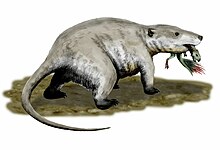Gobiconodontidae
| Gobiconodontidae | ||||||||||||
|---|---|---|---|---|---|---|---|---|---|---|---|---|
|
Life picture of Gobiconodon |
||||||||||||
| Temporal occurrence | ||||||||||||
| Lower Cretaceous to Eocene | ||||||||||||
| 130 to 110 million years | ||||||||||||
| Locations | ||||||||||||
|
||||||||||||
| Systematics | ||||||||||||
|
||||||||||||
| Scientific name | ||||||||||||
| Gobiconodontidae | ||||||||||||
| Chow & Rich , 1984 | ||||||||||||
The Gobiconodontidae are a group of extinct mammals (Mammalia) that lived in the Lower Cretaceous Period . These carnivorous animals include the largest known mammals of the Mesozoic Era , including the Repenomamus .
features
The Gobicodontidae were sturdy animals with short, strong limbs, from whose structure one can infer a life on land. The body size within this group fluctuated considerably, in addition to a few mouse to rabbit-sized representatives, Repenomamus reached a head body length of over 50 centimeters and an estimated weight of 12 to 14 kilograms. The length of the skull varied accordingly and was between 2.7 and 16 centimeters. Noteworthy are individual additional joints on the processes of the thoracic vertebrae and the anterior lumbar vertebrae ( xenarthral or secondary joints), which anchor the spine more strongly. Such features are mainly known from today's secondary articulated animals from South America and among others from Fruitafossor , another Mesozoic mammal from today's Colorado.
The incisors were large and pointed, the molars (back teeth) of these animals had three cusps arranged one behind the other, a feature that is also found in other mammals ( eutriconodonta ) of the Mesozoic. The middle hump was significantly larger than the other two, it is also slightly offset to the center, which anticipates the triangular arrangement that occurs in later groups of mammals. The tooth formula (as far as known) should have been I 2 / 2-3 C 1/1 P 3-4 / 2-3 M 4 / 4-5. The sharp teeth were all designed for carnal nourishment; at least Repenomamus is known to eat other mammals and small dinosaurs ( Psittacosaurus ).
Development history and external systematics
The Gobiconodontidae are so far only known from a comparatively short section, the Lower Cretaceous Period , the fossil finds come from Asia and North America and thus from the former northern continent Laurasia .
There are a number of Mesozoic mammals whose molars are characterized by three cusps arranged one behind the other. Together they are classified in the group of eutriconodonta . However, whether these are really closely related animals or just convergent developments is a matter of dispute. Their position in the mammalian system is also unclear, but it is likely to have been a relatively early, specialized branch. Accordingly, they are not closely related to any modern mammal group.
Internal system

Several genera of Gobiconodontidae have been described, with the genus Repenomamus sometimes being in a separate family, Repenomamidae. This separation is justified by differences in the structure and number of teeth, but it is certain that it is closely related to the other genera listed here.
- Several species of the genus Gobiconodon have been described, which differ significantly in terms of size, their skull length varies between three and ten centimeters. Finds are attested from the USA , Russia , Mongolia and China (from the Yixian formation , which is also known for its feathered dinosaurs ).
- From Hangjinia only parts of the lower jaw are known so far.
- Meemannodon was a comparatively large representative who is also known from the Yixian formation.
- Repenomamus was the largest representative of this group and the largest known mammal of the Mesozoic Era. Two species of different sizes, R. giganticus and R. robustus, have been described, both of which are also known from the Yixian formation.
- Spinolestes is represented by an almost complete skeleton with preserved soft tissue anatomy, such as the skin, ears and some internal organs, which comes from Spain and dates back to the Barremian 127 to 125 million years ago. The animal, which weighs only 56 to 72 g, lived on the ground, but could possibly also dig in the ground.
literature
- Thomas S. Kemp: The Origin & Evolution of Mammals . Oxford University Press, Oxford 2005, 331 pages, ISBN 0-19-850761-5 .
Individual evidence
- ^ A b Thomas Martin, Jesús Marugán-Lobón, Romain Vullo, Hugo Martín-Abad, Zhe-Xi Luo and Angela D. Buscalion: A Cretaceous eutriconodont and integument evolution in early mammals. Nature 526, 2015, pp. 380-384